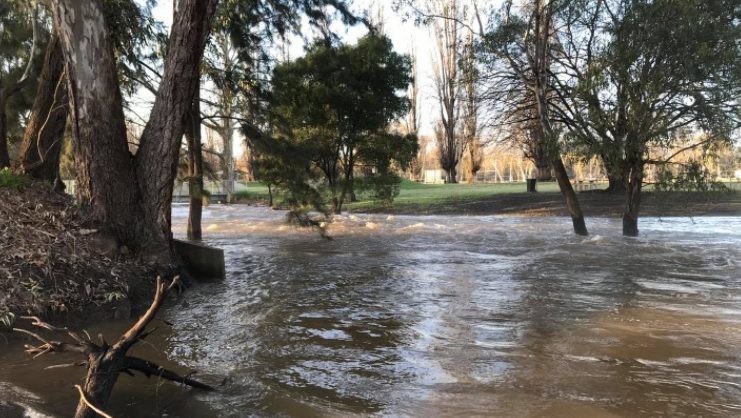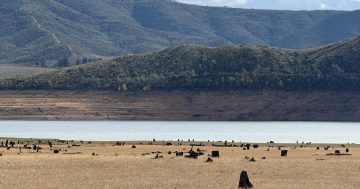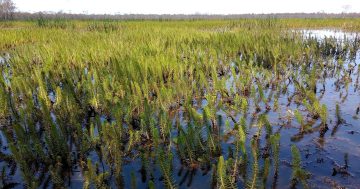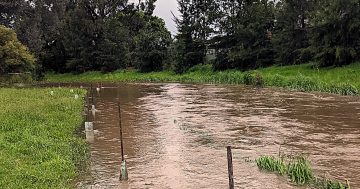
Water started flowing over the spillway at Blowering Dam this week for the first time since 2016. Photo: Halp Ton, Gundagai Floods Facebook page.
It hasn’t happened since 2016, but this week Blowering and Burrinjuck dams finally breached their spillways after reaching capacity, giving downstream residents a reason to hold their breath and farmers a reason to breathe a little easier.
It’s taken a while for the two dams in the south to fill after years of protracted drought, but steady falls of rain in the past year, especially in recent months, has them at just over 100 per cent.
The reward was an easing of rain and a few days of sunshine – thankfully – as warnings were issued for flooding in low-lying areas in the Yass, Tumut and Murrumbidgee valleys.
But for the first time since 2012 – with the exception of a wet 2016 – there is some water security for the agricultural regions served by the Murrumbidgee.

River levels rise near Morleys Creek campgrounds at Gundagai. Photo: Peter Reardon, Gundagai Floods Facebook page.
Landholders were being urged to relocate livestock and infrastructure from areas prone to inundation as pre-flood releases from two dams and downstream tributary flows lift river heights to near minor flood levels into the weekend and next week.
The Tumut River at Tumut was expected to reach the minor flood level of 2.0 metres on Friday, while minor flooding was also expected along the Murrumbidgee River at Gundagai on Thursday and into Friday, and further downstream at Narrandera and Darlington Point next week.
Dam releases are expected to increase as downstream tributary flows decline to ensure a river height just below minor flood level, to reduce dam storage capacity in anticipation of further inflows.
NSW Water Minister Melinda Pavey said the challenge now for Water NSW was managing storage across the state with wet catchments and the possibility of flooding.
“We’ve got Water NSW on a completely different footing and setting [from during the drought] out there talking to communities, checking flood gauges, ensuring the rivers are running well, but also being prepared for warnings.”
They work with the Bureau of Meteorology and local communities and monitor downstream tributary flow to calculate ongoing release patterns with forecasts indicating a wetter than average spring.

The low-level bridge over the Murrumbidgee River at Jugiong. Photo: Carmel Sommer, Gundagai Floods Facebook page.
WaterNSW spokesman Tony Webber said it was a delicate balancing act.
“There’s this myth for the community is that all the water in the river originates at the dam,” he explained.
“Most of the water in the river stems from tributary inflows which existed long before the dams were built.
“The risk here is that we say, ‘OK, we’re going to get a lot of rain, we’re going to get inflows, let’s get rid of the water out of the dam’ – but we’re putting it into a river that’s already flood-prone, so if you’re reckless or your timing is bad you make the flow higher downstream or if it’s flooding you make the flooding worse.
“Our strategy, in conditions like this, is that you capture what you can, wait until the downstream tributaries peak and start to fall, and you start some small releases from the dam to prepare for the next rain event.
“We don’t release water in sufficient volume to raise the river level any more than it was,” he said.
Airspace releases – additional releases to build storage capacity to absorb the next inflows – have been underway at Burrinjuck dam since early July when it was at 80 per cent capacity, with the dam releasing 330,000 megalitres while managing inflows of 530,000 megalitres.
The dam was built to hold 1,026,000 megalitres of water, almost twice as much water as Sydney Harbour.
Burrinjuck is situated high in the mountains of the Great Dividing Range, near the headwaters of the Murrumbidgee River just 60 km from Yass.
It supplies water for towns, river flows, stock and domestic requirements, irrigated agriculture, industry, flood mitigation and environmental flows.
Its catchment area is 12,953 square kilometres, which is larger than the catchment area of the whole of the Snowy Mountains.
Blowering Dam – which in July was at 90 per cent of its total 1,628,000 megalitre capacity – has since received 360,000 megalitres of inflows and released 220,000 megalitres.
The dam – which is 13 kilometres upstream of Tumut – supports irrigated agriculture, water for town supplies, industry and domestic requirements, environmental flows, flood mitigation and recreation.
Its catchment area is 1606 square kilometres and it is one of the largest dams in NSW.













